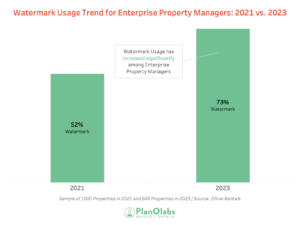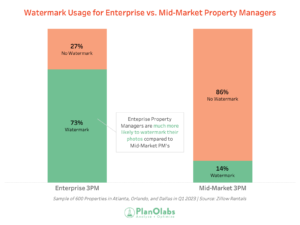Subscribe to our newsletter on LinkedIn
Watermarking may be a 4-letter word to some companies in real estate, but there is no denying the increased usage of watermarks on photos for rental properties. In the past, watermarking has centered around photo ownership and licensing, but the primary use case for a nice watermark has changed.
1. Who is Using Watermarks
In 2021, PlanOlabs conducted a study of watermark usage on rental properties, specifically looking at what the large Enterprise Property Managers are doing (i.e. companies with over 1,000 doors under management). We found that roughly 50% of the time their photos had a watermark.
In Q1 2023, we dove back in to see how that group has changed, and we found the percentage of properties with watermarked photos has ballooned to almost 75% (see chart).

Graph provided by PlanOlabs
In the 2023 study, we also looked at what Mid-Market Property Managers (i.e. companies with less than 1,000 doors under management) are doing. In a sample of over 600 properties, we found that only 14% of properties managed by Mid-Market PMs have watermarked photos (see chart below).

Graph provided by PlanOlabs
This discrepancy begs the question – why? Are Mid-Market PMs making the conscious decision not to watermark their photos? Or do Mid-Market PMs simply not have the tools or resources to create and apply a watermark?
2. Why You Should Use Watermarks
You read my mind… this is a great ChatGPT question, so here is what the robot says:
Benefits of watermarking photos:
- Prevents unauthorized use of the photo: Watermarking photos can discourage unauthorized use and protect the property manager’s intellectual property rights.
- Promotes brand recognition: Watermarking photos can help increase brand recognition by making it easier for potential clients to identify the source of the photo.
- Provides contact information: A watermark can include the property manager’s contact information, making it easy for potential clients to get in touch.
But not only did I ask the bots about the benefits of watermarks, but I also asked humans that are actively using watermarks, and here is what they say:
“Watermarking does more than prevent fraud; it also amplifies our brand and legitimizes our business as a professional property management company in the eyes of prospective residents.”
-Gregg Higgins, Marketing Director at ResiHome
“Our primary use for watermarks is to reduce scams. Specifically, the watermark adds to the difficulty for scammers to repurpose our photos on a fake rental listing. Second, it’s another opportunity for us to promote our brand and shorten the gap from a prospect viewing one of our homes online to getting them to book a showing/submit an application.”
-Jackson Kirtley, Director of Strategy at RENU Management
“We use Watermarks for two main reasons:
- To help prevent scams/fraud
- To promote our brand. Imagine Homes invests significantly in each of our assets. We want to show off our best-in-class product; when someone sees our high-quality pictures, they should instantly know there is a best-in-class operation behind it.”
-Jake Holzman, Senior VP of Operations at Imagine Homes
3. How You Can Implement Watermarks (be careful here!)
OK, watermarks seem like a pretty good idea. Going back to ChatGPT, here are some things to be mindful of when implementing them:
Drawbacks of watermarking photos:
- Distracting: Watermarks can be distracting and take away from the photo’s overall aesthetic.
- Can be removed: While a watermark can discourage unauthorized use, it can be removed or cropped out by someone with basic photo editing skills.
- Time-consuming: Watermarking photos can be a time-consuming process, especially if the property manager has a large number of photos to watermark.
Let’s address these one at a time.
Distracting
…only if your actual watermark is distracting. PlanOmatic clients have adopted a simple, translucent, white version of their logo that does not distract at all. Consider the two examples below. Be sure to avoid using color text, and use an actual logo as part of your watermark to legitimize your business.


Can be Removed
…only if you tuck a tiny watermark into a corner. The current industry best practice is a translucent center overlay watermark, that way it becomes nearly impossible to photoshop it out without also cropping out the home.

Good luck removing this watermark!
Time-Consuming
…that’s what PlanOmatic is here for! If you don’t have Photoshop or design experts on staff, we provide watermark consultation and creation as a complimentary part of our service. Stop manually adding your watermark to each photo. When you use PlanOmatic, we deliver a set of clean and watermarked photos with every shoot.
Summary For Your Investor
- Enterprise Property Management companies have adopted watermarked photos as an industry standard with almost 75% of their properties using a watermark. Mid-Market Property Management meanwhile has fallen behind, with only 14% usage.
- The three main benefits of using watermarks are:
- Prevent scams
- Promote brand awareness
- Legitimize your business
- There is such a thing as a distracting watermark that can negatively impact the aesthetics of your photos. Follow best practices (or use a partner like PlanOmatic) to create something that represents the home and your brand in a positive light.



